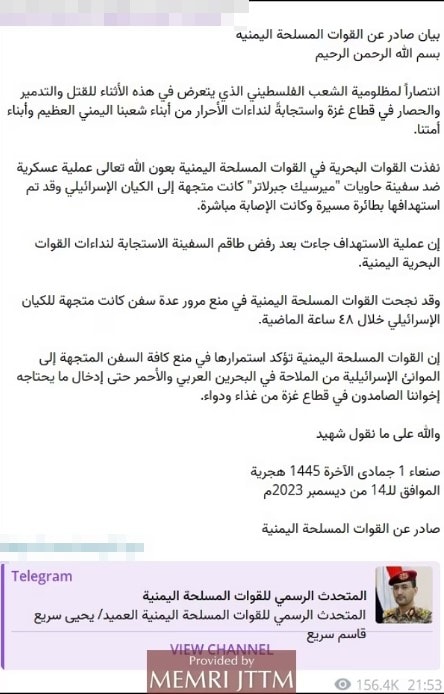The following report is now a complimentary offering from MEMRI's Jihad and Terrorism Threat Monitor (JTTM). For JTTM subscription information, click here.
On December 14, 2023, the Houthi Ansar Allah movement's armed forces claimed a drone attack on the Maersk Gibraltar container ship bound which, they said, was bound for the "Zionist entity." The spokesperson of the Houthi armed forces, Brigadier-General Yahya Saree', said that the strike had accurately hit the target and was carried out after the ship failed to heed the warnings of the Yemeni navy.
A December 15 report by U.S. Central Command (CENTCOM) on this incident states that, "on midday on December 14 (Sanaa time), a ballistic missile was fired from a Houthi-controlled area of Yemen toward the international shipping lane north of Bab El-Mandeb. There were no injuries or damage. Following the missile launch, the M/V Maersk Gibraltar was hailed by the Houthis, who threatened further missile attacks. The M/V Maersk Gibraltar is a Hong Kong-flagged cargo container vessel."[1]
Below are further details about this incident and statements released regarding it:
As mentioned, the December 14 official statement by Houthi spokesperson Saree' claimed responsibility for the attack on the Maersk Gibraltar. It added that, in the last two days, Yemen's armed forces have also managed to prevent the passage of several other ships on their way to the "Israeli entity," and that they would continue to prevent the passage of such ships through the Red Sea and Arabian Sea, "until our steadfast brothers in Gaza receive the food and medicine they need."[2]

A December 15 report in the pro-Hizbullah Lebanese daily Al-Akhbar states, citing "knowledgeable sources," that on December 14 the Houthis prevented the passage of two ships through the Bab El-Mandeb strait. It adds that, according to other sources, a third ship was attacked in the Indian Ocean, near Yemen's Socotra Island. This escalation, it explains, comes against the backdrop of the U.S. efforts to form a "military coalition against Sanaa." However, the daily quotes "sources in Sanaa" as denying British reports, from December 13, that the Houthis captured a ship in the Arabian Sea, east of the Somali city of Bossaso. These sources stress that the Yemenis had nothing to do with that incident, and assess that it was "staged in order to encourage more countries to join the military coalition Washington is acting to form in order to protect Israeli ships."[3]

CENTCOM reported on December 14 that, "at approximately 0830 (Sanaa time) on December 13, in the southern Red Sea, the Arleigh-Burke class guided-missile destroyer USS Mason (DDG 87) was responding to a mayday call from the Marshall Islands-flagged tanker Motor Vessel Ardmore Encounter, which was under attack from Houthi forces. These forces first attempted to board the tanker via skiffs.
"When this was unsuccessful, a pair of missiles were fired from Houthi-controlled areas of Yemen at the vessel, which both missed. While responding to the distress call, the Mason shot down an unmanned aerial vehicle also launched from Houthi-controlled areas. The UAV was heading directly towards the Mason and was shot down in self-defense."[4]
These Houthi attacks come in the wake of the December 12 rocket attack on the Norwegian commercial tanker STRINDA, which was also allegedly bound for Israel. [5] They also follow statements by Houthi officials, who said that support of Gaza must be translated into action and that the only way to restore calm in Red Sea is to restore calm in Gaza. [6]
[1] Twitter.com/CENTCOM, December 15, 2023.
[2] Telegram, December 14, 2023.
[3] Al-Akhbar, December 15, 2023.
[4] Twitter.com/CENTCOM, December 14, 2023.
The full text of this post is available to subscribers.
Please login or register to request subscription information from MEMRI



